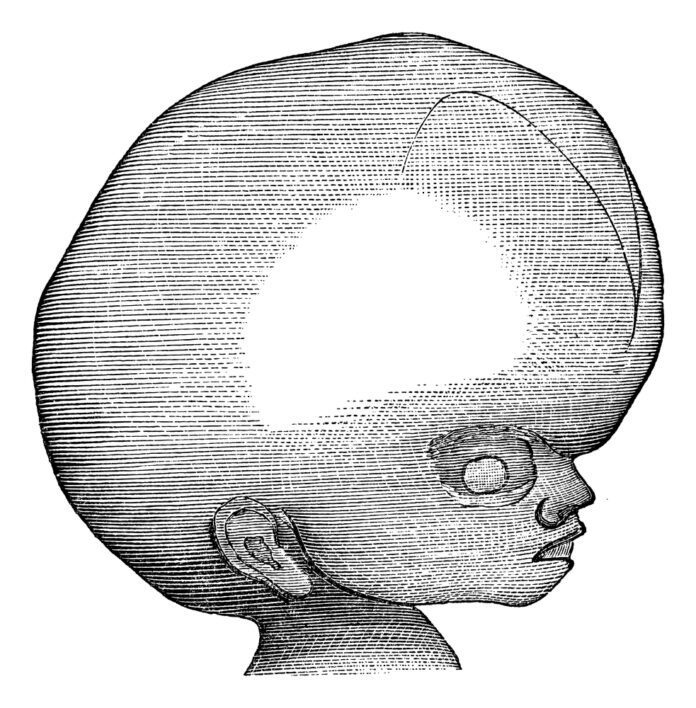Overview
Hydrocephalus is a buildup of fluid inside the skull that leads to swelling inside the brain. Hydrocephalus means “water on the brain.”
Causes Of Water On The Brain (Hydrocephalus)
The cause of hydrocephalus is a problem with the flow of the fluid surrounding the brain. This fluid is cerebrospinal fluid, or CSF, which surrounds the brain and spinal cord, and helps to cushion the brain.
CSF typically moves through the brain and the spinal cord. It is also soaked into the bloodstream. CSF levels can rise in the brain if:
- The flow of CSF becomes blocked.
- The fluid is not properly absorbed into the blood.
- The brain makes too much of the CSF fluid.
- Too much CSF puts pressure on the brain. This pushes the brain against the skull and damages brain tissue.
Hydrocephalus may start while the baby is growing inside the womb. It is common in babies who have myelomeningocele, which is a birth defect in which the spinal column doesn’t properly close.
Hydrocephalus may also be due to the following:
- Genetic defects
- Certain infections during pregnancy
In young children, hydrocephalus may be due to:
- Infections that affect the central nervous system (such as meningitis or encephalitis), especially in infants.
- Bleeding in the brain during or soon after delivery (especially in premature babies).
- Injury before, during, or after childbirth, including subarachnoid hemorrhage.
- Tumors of the central nervous system, including the brain or spinal cord.
- Injury or trauma.
- Hydrocephalus most often occurs in children. Another type, called normal pressure hydrocephalus, may occur in adults and older people.
Symptoms Of Water On The Brain (Hydrocephalus)
Symptoms of hydrocephalus depend on:
- Age
- Amount of brain damage
- What is causing the buildup of CSF fluid
Hydrocephalus causes the fontanelle (soft spot) in infants to bulge and the head to be larger than expected. Early symptoms may include:
- Eyes that appear to gaze downward
- Irritability
- Seizures
- Separated sutures
- Sleepiness
- Vomiting
Symptoms that may occur in older children can include:
- Brief, shrill, high-pitched cry
- Changes in personality, memory, or the ability to think or reason
- Changes in facial appearance and eye spacing
- Crossed eyes or uncontrolled eye movements
- Difficulty feeding
- Excessive sleepiness
- Headache
- Irritability, poor temper control
- Loss of bladder control (urinary incontinence)
- Loss of coordination and trouble walking
- Muscle spasticity (spasm)
- Slow growth (child 0 to 5 years)
- Slow or restricted movement
- Vomiting
Exams & Tests
A health care provider will examine the baby. This may show:
- Stretched or swollen veins on the baby’s scalp.
- Abnormal sounds when the provider taps lightly on the skull, suggesting a problem with the skull bones.
- All or part of the head may be larger than normal, often the front part.
- Eyes that look “sunken in.”
- The white part of the eye appears over the colored area, making it look like a “setting sun.”
- Reflexes may be normal.
- Repeated head circumference measurements over time may show that the head is getting bigger.
In terms of identifying hydrocephalus, a head CT scan is one of the best tests to complete. Other tests that may be done include:
- Arteriography
- Brain scan using radioisotopes
- Cranial ultrasound (an ultrasound of the brain)
- Lumbar puncture and examination of the cerebrospinal fluid (rarely done)
- Skull x-rays
Treatment Of Water On The Brain (Hydrocephalus)
The goal of treatment is to reduce or prevent brain damage by improving the flow of CSF.
Surgery may be done to remove a blockage, if possible.
If not, a flexible tube called a shunt may be placed in the brain to reroute the flow of CSF. The shunt sends CSF to another part of the body, such as the belly area, where it can be absorbed.
Other treatments may include:
- Antibiotics if there are signs of infection. Severe infections may require the shunt to be removed.
- A procedure called endoscopic third ventriculostomy (ETV), which relieves pressure without replacing the shunt.
- Removing or burning away (cauterizing) the parts of the brain that produce CSF.
- The child will need regular check-ups to make sure there are no further problems. Tests will be done regularly to check the child’s development, and to look for intellectual, neurological, or physical problems.
Visiting nurses, social services, support groups, and local agencies can provide emotional support and help with the care of a child with hydrocephalus who has serious brain damage.



